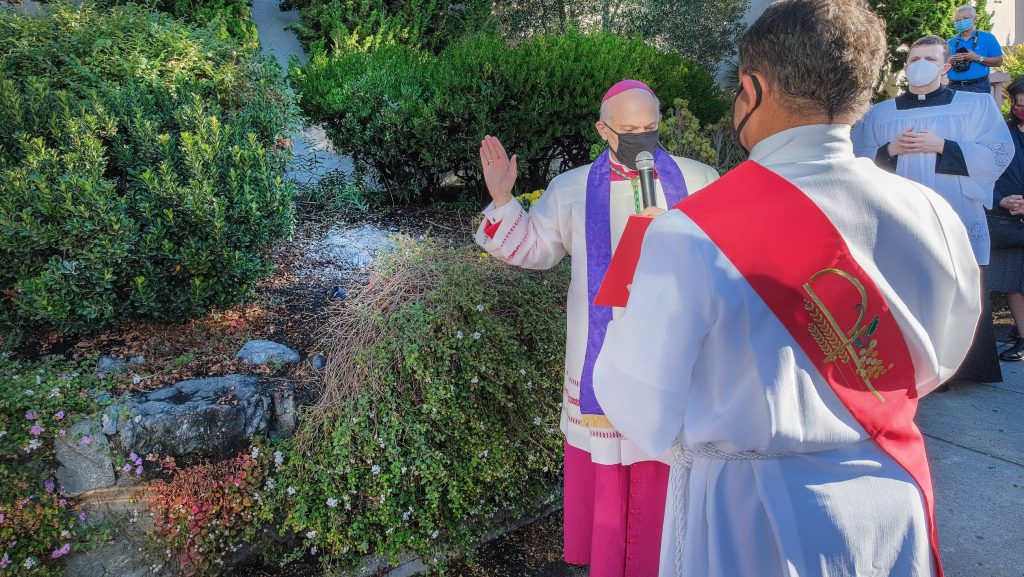Archbishop Salvatore Cordileone of San Francisco has asked the Marin County district attorney to prosecute those arrested after an Oct. 12 riot at a mission church to the “full extent of the law,” after several of the rioters defaced and pulled to the ground a statue of St. Junípero Serra.
“This attack on a cherished religious symbol on our own church property is not a minor property crime, but an attack on Catholics as a people,” Cordileone wrote in an Oct. 26 letter to Lori Frugoli, the Marin County district attorney.
“If the perpetrators of this crime are not brought to justice, small mobs will be able to decide what religious symbols all people of faith may display on their own property to further their faith, and they will continue to inflict considerable spiritual suffering on ordinary Catholic people who would see our sacred spaces as unprotected by law.”
The riot that led to the statue’s destruction took place Oct. 12— which California and several other states mark as Indigenous Peoples Day— at Mission San Rafael Arcángel in San Rafael, about 20 miles north of San Francisco.
Critics have lambasted Serra as a symbol of European colonialism and the erasure of Native culture, and have in recent years sought to remove monuments to him and change the names of streets or landmarks named for him.
During the hourlong protest, organized by members of the Coast Miwok tribe, several masked people peeled off the duct tape and threw red paint in the statue’s face. At least five people can be seen pulling on the statue’s head with nylon cords and ropes.
Catholics rallied in a peaceful prayer demonstration the day after the riot, with Father Kyle Faller, parochial vicar at the mission, leading a rosary and urging the crowd of 75-100 people to persevere in prayer, and offering a reflection on Jesus’ forgiveness in the face of persecution.
Cordileone performed an exorcism at the site of the statue Oct. 17, calling the statue’s destruction an “act of blasphemy.”
The San Rafael Police Department said in an Oct. 13 statement that five women had been arrested, issued citations and released, and that the cases had been forwarded to the district attorney’s office for prosecution. Police have also recommended charges for a sixth person they identified later, but whose name they have not released publicly.
Two of the women charged hailed from Oakland, one was a local, and two were from nearby communities.
Cordileone seconded the San Rafael Police Department’s request that the six individuals be charged with— in addition to trespassing and conspiracy— felony vandalism and vandalism in a house of worship, a hate crime.
Cordileone also thanked the police for their efforts. The department said they had worked with representatives from the Archdiocese of San Francisco to develop a plan in response to the Oct. 12 protest, as the protest’s organizers had announced the gathering on social media before it took place.
“I would like, on behalf of thousands of Catholics in the Bay Area and around this country, to thank the San Rafael Police both for arresting the miscreants and for being the first lawful civil authority to recognize that this crime they witnessed is a serious assault against a whole people’s right to display the religious symbols they wish on their own property,” Cordileone said.
Frugoli said last week that her office was reviewing the case and had not yet made a decision about whether to pursue criminal charges, the Marin Independent Journal reported.
Lucina Vidauri, one of the event’s organizers, told the Marin Independent Journal that the organizers of the demonstration never intended to vandalize the statue.
The demonstrators were calling for the mission to remove the Serra statue, and “it just got carried away,” she told the paper.
Vidauri declined CNA’s request for an interview.
CNA also attempted to contact Dean Hoaglin, chair of the Coast Miwok Tribal Council of Marin and another organizer of the Oct. 12 protest, for further information on the tribe and their reasons for opposing Serra, but did not receive a reply by press time.
The Coast Miwok people were the original inhabitants of what is today Marin and southern Sonoma Counties of California. The tribe gained federal recognition as the Federated Indians of Graton Rancheria in December 2000.
In 2008, the former bishop of Sacramento, Francis Quinn, apologized to the Coast Miwok tribe that the Spanish “tried to impose a European Catholicism on the natives.”
The vandalism in San Rafael is the latest in a series of attacks on churches and Catholic statues across the country this year. On July 11, a fire under investigation for arson gutted the 249-year-old Mission San Gabriel in Los Angeles, a mission church founded by St. Serra.
During the eighteenth century, Serra founded nine Catholic missions in the area that would later become California, and many of those missions would go on to become the centers of major California cities. Though Serra himself did not found Mission San Rafael, it owes its existence to Serra’s legacy.
Serra’s defenders say that he was actually an advocate for native people, noting an episode of his life when he drafted a 33-point “bill of rights” for the Native Americans living in the mission settlements, and walked from California to Mexico City to present it to the viceroy.
While many Native peoples did suffer horrific abuse, an archaeologist told CNA earlier this year that activists tend to conflate the abuses the Natives suffered long after Serra’s death with the period when Serra was alive and building the missions.
The Benedict XVI Institute for Sacred Music and Divine Worship, a ministry of the archdiocese, on Oct. 28 announced a new fund, under the archbishop’s personal discretion and control, to support “ongoing efforts to advocate for fair treatment for faith communities in exercising their First Amendment right to worship and for protection of our holy ground from vandalism and mob attacks.”

